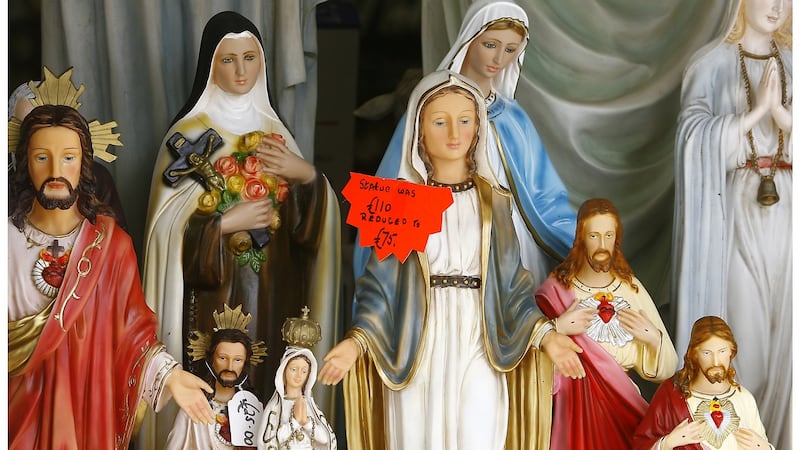The new documentary Strange Occurrences in a Small Irish Village portrays Knock in Co Mayo through a host of characters involved in the life of "Ireland's National Marian Shrine". Among them is Bernard Byrne, filmed in his religious goods emporium among a cram of objects – devotional cards, bookmarks, medals and plaster statuettes. In one of the lighter moments of this sometimes-unsettling film, Byrne shows a catalogue of products including statues of various saints in a range of sizes – a collision of holiness, mechanisation and commerce. From a design perspective, a remarkable aspect of the objects depicted is how little they appear to have changed for more than a century.
If you had a vision of the religious objects and devotional life in Ireland 200 years ago, and then 50 years later, the contrast would be remarkable. Save for some wealthier areas, up to the mid-19th century Catholic objects tended to be very simple, and made of local materials such as thorn rosaries and straw crosses. But by the time of the apparitions in Knock in August 1879 a "devotional revolution" had seen the importation of mass-produced religious objects on a colossal scale.
At first, rosary beads and images were intended for the use of the growing number of religious personnel, and then came to be distributed to the laity, often by missionary orders from continental Europe. The attempts to standardise Irish religious expression to be more in keeping with approved norms was thus partly based on the systematic design and "proper" use of very particular objects.

Witnesses
The statements of the witnesses to the vision in Knock are very telling of this new, more material form of religion. Unlike
Bernadette Soubirous
at
Lourdes
20 years previously, or the visionaries in Fatima 50 years later, those at Knock did not describe their divine encounter in terms of interacting with an actual personage but spoke of “figures” and “images”, and more than one likened what they saw to statues. In fact, one witness thought at first that the parish priest had placed statues outside while renovating the church.
The reports, as filtered and recast through an investigating commission, were odd in other ways. As well as Mary, the witnesses saw St Joseph and a figure described by some as St John the Evangelist with a bishop's mitre – recognisable to Mary Byrne because she once "saw a statue at the chapel of Lecanvey, near Westport, Co Mayo, very much resembling the figure". Some of the testimonies also mention a lamb on an altar, sometimes with a cross behind it. As an icon rather than a figure, this element disrupts the sense of Knock as a typical modern vision involving an actual meeting with a divine personage. Rather, it suggests the "Lamb of God" popularised through the French holy cards that were widely distributed through schools and parish missions (as described in Emma Donoghue's new book The Wonder) and medals distributed by Fr Theobald Mathew in his Temperance Crusade.
In his study of the Knock apparition, historian Eugene Hynes mentions the possible familiarity of the witnesses with a stained glass window in nearby Ballyhaunis that had a similar composition, a suggestion that, along with references to statues and the lamb, emphasises the importance of very particular forms of religious material culture in creating an imaginary image of the divine.
The goods sold by Bernard Byrne seem to conform to standardised depictions established long ago. What has changed is whom they depict, partly determined by the age profile of the main consumers of these items. Whereas St Gerard Majella and St Rita were once popular in an Ireland of large families due to their relationship to childbirth and marriages, images of St Peregrine (patron of cancer patients) and St Andrew Avellino (of stroke victims) are now better sellers.
Disconcerting
The most memorable, and disconcerting, item shown in
Strange Occurrences
is the “Rosary of the Unborn”. Each bead contains a tiny model of an embryo, and it is described as designed to “save a baby from abortion” if prayed with.
The suffering of live-born children at the hands of religious is referred to in the film in rather more euphemistic terms as “the scandals”. But their presence seems to haunt it. As the documentary and indeed the apparition at Knock demonstrate, interactions between the personnel and institutions of religion and individual belief is always complex.
However, as also hinted at, for a true reckoning of Catholicism in Ireland, the most awful occurrences still need to be fully brought to light, and witnessed.












